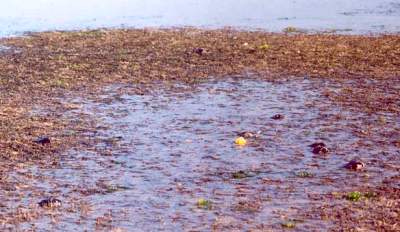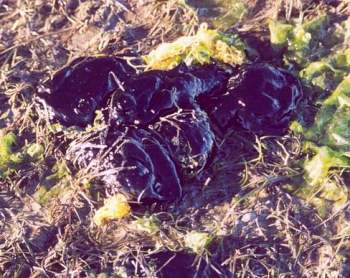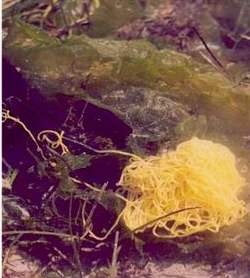Aplysia juliana - breeding in NZ
August 16, 2003
From: Paul Furneaux

Dear Bill,
I've been monitoring the activity of a group of Aplysia juliana that I first noticed on July 14th this year, and they have been very busy mating and laying egg-masses for the past 4 weeks and as yet show no signs of slowing down. The area is the same one that I have been working in for the past several months in Tauranga Harbour, New Zealand, and the Aplysia have confined themselves to a particular area of about 140m by 110m, which is very close to the low tide mark and has some areas of Zostera "banks" that dry off briefly at low tide and other areas that retain 5-10cm of water at low tide. The whole area is covered in the sea grass Zostera and also has a good supply of the green alga Ulva.
The Aplysia seemed to be focused on breeding but at low tide when I visit them they are "resting", often out of the water, sometimes covered in Ulva, sometimes partly buried in mud, and seem uninterested in moving even when placed in the water.The evidence of their mating activity is everywhere to see in the form of their bright yellow egg masses which are stuck to Zostera or Ulva. Over the past 4 weeks I have counted both the Aplysia numbers and the egg-mass numbers and the interesting thing is that although the Aplysia numbers fluctuate between 76 to 217 animals, the egg-mass numbers have never risen above about 150, despite the best efforts of the Aplysia, whose daily efforts in egg-mass production are quite extraordinary so I assume that the egg-masses are being predated on but by what I am unable to figure out. There are many candidates.
Anyway, they are of great interest to me and I've decided to keep a tiny sample of their eggs in a tank to follow proceedings more closely, I'll keep you posted on progress.
Regards,
Paul Furneaux.
P.Furneaux@xtra.co.nz


Thanks Paul,
It would certainly be interesting to know what is eating the egg masses as it is thought that Sea Hare eggs could be protected from predation, by various chemicals, perhaps derived from their plant food.
Best wishes,
Bill Rudman
Related messages
-
Sea hares from Tristan da Cunha
From: Sue Scott, June 1, 2010 -
Aplysia juliana? from Reunion Island
From: Philibert Bidgrain, January 31, 2007 -
Re: Aplysia juliana in my aquarium
From: Michelle Yerman, May 25, 2006 -
Aplysia juliana in my aquarium
From: Michelle Yerman, May 19, 2006 -
Aplysia juliana eaten by Flatworm
From: Lisa Kirkendale, April 10, 2006 -
Re: Sea Hares laying noodle shaped things in tank
From: Marcus van Riet, December 17, 2005 -
Sea Hares laying noodle shaped things in tank
From: Marcus van Riet, December 6, 2005 -
Aplysia juliana? in Kiama rock pools, NSW
From: Francis Hawkshaw, August 9, 2005 -
Aplysia juliana being eaten by crab
From: Dong Bum Koh, June 7, 2005 -
Aplysia juliana laying eggs
From: Dong Bum Koh, May 25, 2005 -
Aplysia juliana - breeding in Tasmania
From: Melanie Godfrey-Smith, November 16, 2003 -
Aplysia juliana from New Zealand
From: Paul Furneaux, June 30, 2003 -
Sea hares, mating pair - from Sydney
From: Iain Whyte, November 30, 2002 -
Aplysia juliana from Korea
From: Ronald Noseworthy, June 19, 2002 -
Re: Aplysia from Taiwan
From: Tony Wright, April 16, 2001 -
Aplysia from Taiwan
From: Tony Wright, April 14, 2001 -
Sea Slug feeding and babies
From: Andrew McDonald, February 16, 2000
